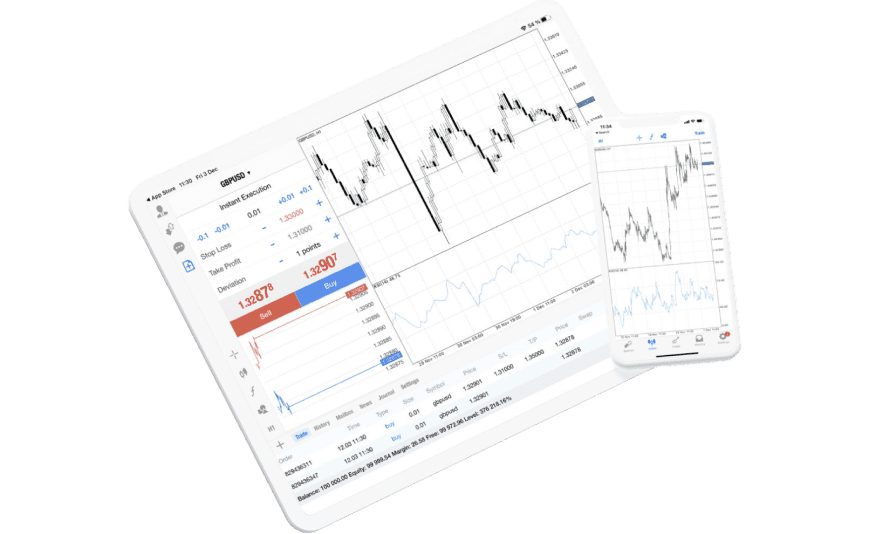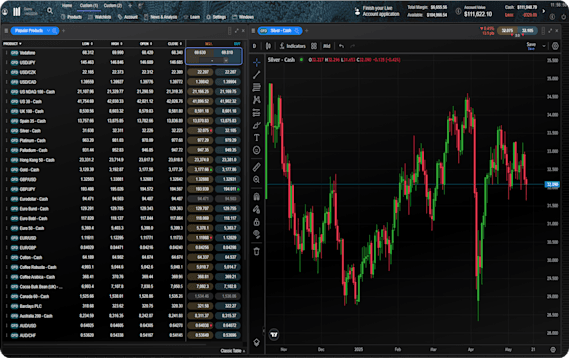An award-winning trading experience for CFD traders¹


Pips FX minimum spread²
Maximum retail leverage
Micro lot trading*
Financial instruments³
Dedicated customer support
*Trade one-hundredth the size of a standard lot
Why trade with CMC Markets?
Founded in 1989, CMC Markets provides its clients with local expertise, backed by the security and financial strength of a global company.
Our MetaTrader platforms have no restrictions on minimum stop-loss or take-profit distances and limits, especially useful for high-volume traders.
Hone your technical analysis with our suite of free additional premium indicators and EAs.
Deposit and withdraw funds easily, and whenever you want to.
Aside from just a few breaks, you can trade CFDs on indices, forex, commodities and cryptocurrencies around the clock, 5 days a week.
Instruments
Our platforms at a glance
MetaTrader 4
Trade on the world's most popular trading platform, with tight spreads and ultra-fast execution.
Trade on forex, indices, commodities and cryptocurrencies
- Spreads start from 0.0 pips with our FX Active account⁴
Fast, one-click trading
- Lightning-fast execution ⁴
Customisable charts with pre-installed indicators
Automated trading with Expert Advisors

Mobile

Desktop
Download MetaTrader 4 for PC or MAC and trade on the world's most popular trading platform.
MetaTrader 5
A powerful trading platform designed to provide access to global markets, with advanced trading features and real-time data.
Trade on forex, indices, commodities, shares and cryptos
- Spreads from 0.0 pips with our FX Active account⁵
One-click trading
- Ultra-fast execution⁴
More order types, timeframes, and pre-installed indicators than on MT4
Depth of market display and inbuilt economic calendar
Experts Advisors with faster strategy tester

Mobile

Desktop
Download MetaTrader 5 for PC or MAC to experience its advanced trading tools and features from an industry’s leading provider.
TradingView
Enjoy the best of both worlds: view and analyse charts on TradingView; trade with our tight spreads and fast execution.
Enhance your trading experience with TradingView’s renowned charts and indicators.
Get inspiration and ideas from one of the world’s largest online trading communities.
Prepare for key announcements with TradingView's easy-to-use financial calendar.
Set up personalised alerts using 13 built-in conditions based on price and volume.
Open, manage and close your trades with us in TradingView.

Mobile app
TradingView's mobile apps are available on the App Store and Google Play Store. Ensure that your device is up to date and your operating system is supported.
Google PlayApp StoreCMC Web platform
Integrated TradingView charts
Advanced order execution
Optimised mobile platform
TipRanks analysis
Client sentiment tracker
Pattern recognition scanner
Morningstar equity research and Reuters news

Mobile
Packed with powerful features, yet intuitive, and available to all traders. Whatever the next step in your trading journey, our mobile platform can help you get there.

Desktop
We've built our web trading platform to be powerful and intuitive. It combines leading-edge features and security, fast execution, and best-in-class insight and analysis. Designed to support any strategy.
Superior execution and reliability
Our pioneering technology and highly-regarded customer service, alongside a choice of powerful platforms, offers an ideal combination for serious traders.
Your trades will be filled without any dealer intervention.
We fulfil your order without off-quotes, and wherever possible at the price you see.
We consistently achieve almost 100% core platform uptime, so you can focus on your trading.
What are other traders saying about CMC Markets?
Join over 1 million global traders and investors

Apply and verify your account in a few simple steps.

Deposit seamlessly via card, bank transfer or online banking.

Knowledge hub
Enhance your trading knowledge with our MetaTrader trading guides and insightful articles.
Become a CMC Markets partner
Partner with one of the industry's leading CFD and forex brokers. With our advanced IB portal reporting functions and high customer conversion rates, our program is designed to help you grow your business. Be rewarded with generous remunerations, including support for multi-tiered and customisable deals and payments structures. Contact us today to talk with one of our experienced regional representatives.
Become a partner Log in to partner portalTransparency in everything we do
We believe it's important that our clients understand our business model and the value that CMC Markets can provide, whether you’re an individual or a business.
Once you’ve decided which trading platform you prefer to use, you can apply for a MT4/5 account here, or you can apply for a Next Generation account here. To trade on both platforms, you’ll need to make an application for each platform.
As the two platforms operate separately, you’ll need to apply for an MT4/5 account here.
CMC Markets utilises technology that can read a variety of identification and address documents. Generally, we will need an official identification document, such as a passport and a proof of address document like a utility bill or bank statement. You will be prompted to upload electronic versions at the verification stage.
Yes, we offer a free demo account for all platforms. The demo account is a practice account that allows you to trade using virtual funds, so your own funds are not at risk. Create an MT4/5 demo account or, apply for a Next Generation demo account. The MT4 and MT5 demo accounts are available for an initial period of 30 days. Both MT4 and MT5 demo accounts will expire after 30 days of inactivity. The Next Generation demo account has no expiry date.
We offer a standard CFD trading account and our FX Active trading account. The FX Active account features 0.0 minimum spreads on 6 major FX pairs (EUR/USD, AUD/USD, GBP/USD, NZD/USD, USD/CAD, USD/JPY) and charges a 0.0025% commission.
FX Active is designed for active forex traders but also includes all our other instruments, such as indices, shares (MetaTrader 5 and Next Generation platforms only), commodities and cryptocurrencies.
There is no minimum deposit required to open an account. You won’t be able to place a trade until there are sufficient funds to cover your position.
We offer a wide range of payment methods including credit cards, and online banking. To view the full list of deposit methods, log in to your client portal and view the funding options.
Yes, we do offer affiliate and introducer incentives. The program is designed to remunerate and reward introducers and partners who refer clients to CMC Markets. As an affiliate, you can earn a commission for referring new clients to CMC Markets. The commission rate varies depending on the country where your referrals are based. As an introducer, you will earn a commission on the trading activity of your clients. CMC Markets offers flexible and competitive rebate structures, including multi-tiered rebate structures to maximise your earning potential.
Apply here to join the CMC Markets introducer program
CMC Markets has 15 global offices, including in the UK, Australia, Germany, Canada, New Zealand, Singapore and Bermuda. CMC Markets' entities are licensed and regulated by the local authorities, for example, CMC Markets Bermuda is licensed to conduct investment business and digital asset business by the Bermuda Monetary Authority (‘BMA’).
As a CMC Markets' client, your money is held separately from CMC Markets' own funds. It is held in segregated client bank accounts distributed across a range of major banks, which are regularly assessed against our risk criteria. Under the BMA rules, retail clients must be provided with negative balance protection. This means that your maximum loss is the amount you have deposited with us.
If you're trading on MT4 or MT5, select the instrument you wish to trade ('double-click' on your PC), and a new order window will appear. Enter your desired volume (in lots), add any risk-management orders such as a stop-loss or take-profit order. Then place a market order in the direction you wish to trade; buy to go long, or sell to go short. There are several ways to place trades or orders using MT4 or MT5 – you can learn more about MT4 or MT5 functionality by navigating to Help > Help topics or Help > Video guides.
If you’re trading on our Next Generation platform, search for your desired instrument from the 'Product Library'. Select your chosen instrument ('right-click' on your PC), and select ‘Order Ticket’. In the order ticket box, choose your order type (from Market, Limit, and Stop-Entry Order), and then enter your desired volume in units or amount (this can be configured from the ‘Settings’ menu in the main navigation). Add stop-loss and take-profit levels to minimise your risk, and choose to ‘BUY’ or ‘SELL’, depending on whether you want to go long or short. When you’re ready, select ‘Place Buy Market Order’, or ‘Place Sell Market Order’.
For retail clients, the maximum leverage you can currently trade with is 200:1 (or 0.5% margin) with our CFD trading and FX Active accounts.
TradingView is a trading research platform where you can view charts, analyse trends and interact with an online community. You can connect your TradingView account to your CMC Markets account, enabling you to open, manage and close trades within TradingView. Learn more about TradingView here.
MetaQuotes' MetaTrader 4 and MetaTrader 5 are globally popular forex and CFD trading platforms. TradingView is a trading and charting platform which you can link to your broker account to place trades. Our proprietary web-based platform is feature-rich and enables access to trade CFDs on 12,000 instruments.
With each platform you can choose from our CFD trading or FX Active accounts. Our FX Active account offers spreads from 0.0 pips on six major FX pairs, with a 25% spread discount on all other pairs. There is a fixed, low commission at $2.50 per $100,000 notional value traded.
Our trading platform doesn’t require any downloads, while MT4 and MT5 requires downloading to fully utilise its features, such as algorithmic trading (through Expert Advisors) and social trading available via the MQL4 and MQL5 communities.
The MetaTrader platforms offer hedging positions by default, while CMC’s trading platform offers netted positions by default.
Yes, you can open an opposite, related, or alternative trade, with no interruption for traders using Expert Advisors.
Log in to your MT4 or MT5 client portal or our trading platform and follow the instructions in the funding section.
You can reset your MT4/5 account password here and your Next Generation password here.
Our aim is to provide a high level of service to all our clients, all of the time. We value all feedback and use it to enhance our products and services. We appreciate that from time to time things can go wrong, or there can be misunderstandings. We are committed to dealing with queries and complaints positively and sympathetically. Where we are at fault, we aim to put things right at the earliest opportunity. You can find our complaint handling procedure here or contact us at global@cmcmarkets.com to begin your account query. Please note that all queries and complaints will be handled in English.


Ready to get started?
If you already have an account, log in to your chosen platform.
Don't have one yet? Open an account now.
1 Awards include: Best Mobile Trading Platform, ADVFN International Financial Awards 2024; Broker of the Year 2011-2023, Canstar Online Share Trading; No.1 Web Platform, ForexBrokers.com Awards 2023; Best Forex Broker, Good Money Guide Awards 2023; Best In-House Analysts, Professional Trader Awards 2023; No.1 Platform Technology, ForexBrokers.com Awards 2022; Best CFD Provider, Online Money Awards 2022.
3 Spreads from 0.0 pips on six major forex pairs, and a 25% spread discount on 300+ other forex pairs, with a low, fixed commission at $2.50 per $100,000 notional value, with our FX Active account.
4 0.066 seconds MT4 CFD median trade execution time, August 2023.
5 97.876% of MT4 market open orders were filled at quote, 31 August 2023.
6 99.99%+ MT4 core platform uptime, 1-31 August 2023.
